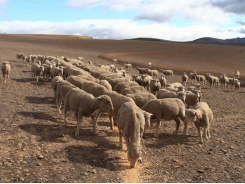Using tannins to control parasites in smallstock

Dr Erika van Zyl discusses alternative manners in which to deal with parasites in smallstock.
Tannin-containing plants such as poor man’s lucerne can halve worm loads in sheep. Photo: Dr Erika van Zyl
Plants containing moderate to high levels of tannins show potential as a complementary method of controlling parasites in smallstock.
Gastrointestinal parasites such as worms are the leading cause of losses in production and profitability in smallstock farming operations.
Symptoms include bottle jaw (a hardened swelling caused by the accumulation of fluid below the jaw), oedema (low blood protein) and anaemia (red blood cell deficiency), all of which can lead to mortalities.
“High worm loads, and the inability to control [them], is one of the main reasons farmers decide to leave the business, especially in the case of intensive farming on pastures,” says Dr Erika van Zyl, a scientist based at the KwaZulu-Natal Department of Agriculture and Rural Development Dundee Research Station.
Her research has shown that bioactive forages – plants containing moderate to high levels of tannins – can play a role in lowering worm loads.
For example, poor man’s lucerne (Lespedeza cuneata), a perennial legume, can reduce worm loads and faecal egg counts in sheep by up to 50% and more, if consumed fresh or as hay.
This is an important finding, considering that worm resistance to chemical anthelmintics (used to prevent the development of internal parasites) is increasing around the globe.
This resistance is caused mainly by under-dosing or continual blanket treatment of animals. Under-dosing eradicates the weaker worms; those that are stronger survive to produce an even more resilient generation, rendering further treatment with that chemical ineffective.
“In countries such as the US, this problem has led to more farmers looking for alternative complementary treatments such as bioactive forages for the holistic control of worms,” explains Van Zyl.
1/ Making tannins more palatable
Historically, plant extracts were used to control internal parasites. These are impractical in large-scale farming operations, however, hence the focus on bioactive forages such as poor man’s lucerne, which can be cultivated relatively cheaply in soil that lacks phosphorus or has a low pH.
A high tannin level makes a plant unpalatable, and some plants therefore increase tannin levels to protect themselves from defoliation. In the case of poor man’s lucerne, however, palatability changes with the weather.
During long periods without rain, voluntary intake by animals decreases because the tannin content in the plant increases as the need to fend off defoliation is greater.
As soon as moisture conditions improve, the tannin content drops and the plant becomes more palatable. And it is precisely during wetter periods – when the legume is more palatable – that the risk of worm infestations is much higher.
Farmers can make use of this concurrence by allowing their smallstock to graze L. cuneata during the wetter periods, says Van Zyl. Alternatively, they can make hay from the legume.
“The benefit of haymaking of this pasture is that in the drying process, the tannin quantity changes [again], making it more palatable than the green matter,” she explains.
Farmers who want to make high-quality hay should do so when the legume is young and not yet woody.
2/ How it works
Tannins benefit smallstock in various ways. Firstly, they bond with the outer covering (the cuticle) of worms and this shortens the lifespan of the worm and degrades the fertility of the parasite, explains Van Zyl.
The second benefit relates to proteins. Worm infestations cause significant protein loss in sheep. The tannins in L. cuneata bond with protein in the rumen to form a ‘bypass protein’.
This safeguards the protein in the rumen, but enables it to be fully digested in the lower parts of the digestive tract. This type of protein thus helps to replenish the protein losses experienced by parasitised animals.
As smallstock increasingly feed on tannin-rich forage, contamination of other pastures by worm eggs decreases over time.
“It isn’t a quick fix, but this approach to grazing will lower the risk of parasite infection for grazing animals,” says Van Zyl.
Related news
Tools

Phối trộn thức ăn chăn nuôi

Pha dung dịch thủy canh

Định mức cho tôm ăn

Phối trộn phân bón NPK

Xác định tỷ lệ tôm sống

Chuyển đổi đơn vị phân bón

Xác định công suất sục khí

Chuyển đổi đơn vị tôm

Tính diện tích nhà kính

Tính thể tích ao



 Novel way to identify milk from grass-fed dairy…
Novel way to identify milk from grass-fed dairy…  Can methane emissions be reduced in dairy cows…
Can methane emissions be reduced in dairy cows…